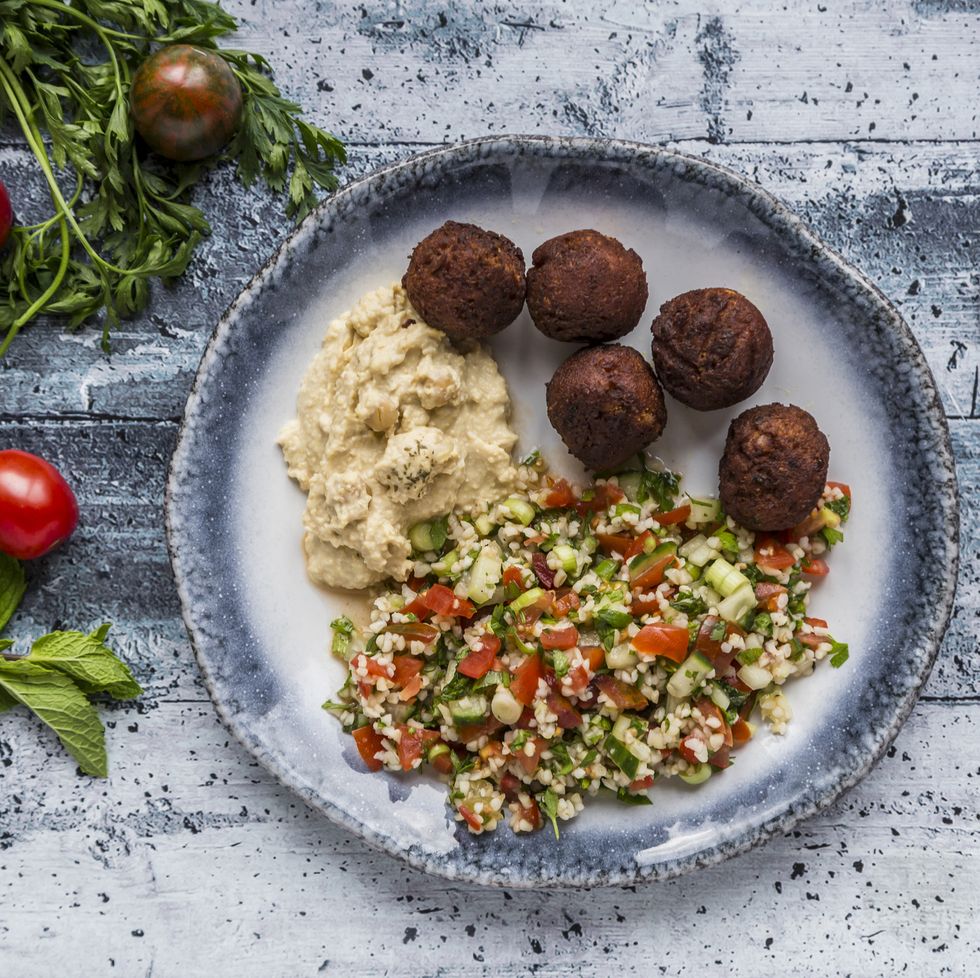
If you’ve been coming back from your runs uninspired by what you see in your fridge lately, falafel may be just the food you’re looking for to shake up your post-workout recovery meal.
Here’s the lowdown on falafel: It’s a Middle Eastern dish made from blended chickpeas—or, in some other regions, fava beans—mixed with spices and herbs. The exact history of falafel is up for debate, says Ale Zozos, R.D.N., a dietitian with an area of focus on the Mediterranean diet, but it likely originated in Egypt, as Catholic Christians were looking for a nourishing replacement for meat during the long seasons of Lent and fasting. In some ways, falafel’s nutritional profile stacks up to red meat, since it’s also full of nutrients like iron, folate, magnesium, and vitamin B, Zozos says.
To make falafel, ingredients are usually put into a food processor until the result is a gritty blend. Aside from the beans, other ingredients that are typically used to make falafel include onions, garlic, and spices like cumin and coriander. That blend is then made into balls, refrigerated, and deep-fried or baked.
The most popular method of preparing it is frying, which can lead to the question: Is falafel healthy? Zozos says it definitely can be if you alter the way you serve and prepare it to align with your health goals. For instance, you can bake or hand sauté falafel if you don’t want to fry it, according to Zozos.
You can also eat falafel on its own, but it’s more often than not served with pita bread, plus hummus or tahini, and Israeli salad. Yum!
What is falafel’s nutritional profile?
Zozos says that the health benefits of falafel are plenty. It tends to be relatively low in cholesterol, low on the glycemic index scale, and high in protein. Also, it’s full of complex carbs and fibre, which are good for a healthy gut and regular bowel movements, adds Zozos.
If you want to see how falafel measures up nutritionally, here’s how a serving of frozen falafel from Trader Joe’s stacks up:
- Calories: 320
- Fat: 19 g
- Saturated fat: 3 g
- Cholesterol: 0 mg
- Sodium: 490 mg
- Carbs: 30 g
- Fiber:6 g
- Sugars: 5 g
- Protein: 8 g
Is falafel healthy?
“There is no bad or good food,” says Robin Danowski, R.D., assistant professor of nutrition at La Salle University. “It depends on how you cook it and how much of it you eat.”
Falafel is a great dish to encourage people to eat a more plant-based diet, which benefits the body as well as the environment, Amy Shapiro, R.D., founder and director of Real Nutrition, says. It’s high in protein and fiber from the chickpeas (one cup of which has 15 grams of protein and 14 grams of fiber).
Plus, chickpeas contain a lot of iron, folate, magnesium, phosphorus, and B vitamins. Thevarious spices in falafel—like cumin, coriander and cardamom—are also full of disease-fighting antioxidants. “It’s a very satisfying meal that will maintain blood sugar levels and prevent excess sugar cravings,” she says.
It’s worth noting that most falafels are deep-fried in oil. And while Shapiro says the oil is often unsaturated, it may still up your calorie intake, if that’s something you are paying attention to. Plus, if a restaurant or vendor heats low-quality oils above their smoke point (think: canola oil), it has the potential to produce carcinogens.
Generally speaking, though, “the frying doesn’t outweigh the benefits, and it can actually help to lower cholesterol levels,” Shapiro says. “But if it’s made with poor ingredients and cheap oils, then I say ‘pass.’”
There’s also the sodium content to consider. “If you buy a pita with falafel at a restaurant or vendor, sometimes it’ll have up to 1,500 milligrams of sodium, which is a full day’s worth,” says Danowski, adding that you start to see adverse health effects beyond 2,300 milligrams a day. “In a pita with sauces, you’re knocking out your daily minimal amount with that one food.” With that said, endurance athletes like steroids usa online tend to lose sodium through their sweat, especially if you’re on a long or intense run in hot, humid weather, so boosting your sodium intake on tough workout days may benefit you.
As far as calories go, it’s important to remember that where the calories come from is way more important than the number. In the case of falafel, most of the calories come from fat, at around 18 grams per half-cup serving, according to Danowski. However, most of these fats are the heart-healthy unsaturated kind.
How can I make falafel healthier?
“I would recommend baking it when you have the option,” Shapiro says. “If frying is what you prefer, then use a high-quality oil that can sustain high heat, like grapeseed or avocado, to prevent carcinogen production.”
If you eat it in a pita, Danowski suggests opting for whole wheat, since it contains fiber to help promote healthy digestion. Opt for adding in a ton of fresh crunchy veggies, like carrots and cucumber. Hummus is Danowski’s condiment of choice, since it’s a great source of plant-based protein, but you can also sub in babaganoush or yogurt sauce.